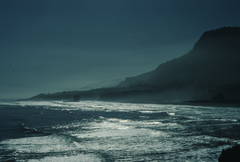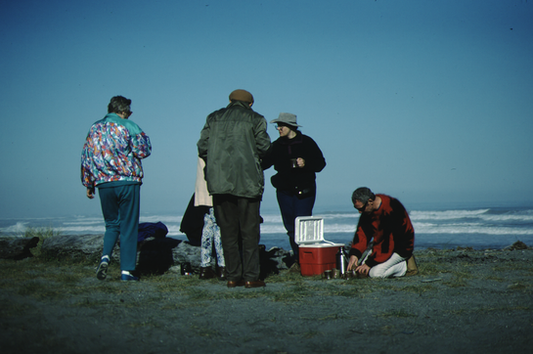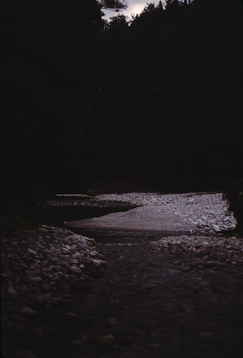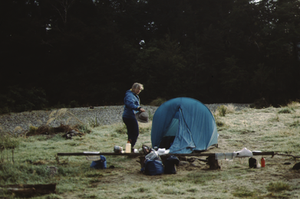
A Short Trip Down a Deep Canyon
An eventful backpacking trip on the South island of New Zealand
The driver of the VW bus lit up a joint and passed it back to me. “Do you want a hit?” she asked. “No thanks,” I said, passing it on to one of her friends next to me. I was thinking, please watch the road. On our left was a sheer rock cliff that towered above us. On our right was a sheer drop into the Tasman Sea. The road snaked back on itself as it carried us south and hopefully not down. After almost meeting death several times in the Paparoa Mountains in the last few days, I did not want to end this trip in the Tasman Sea.
It should have been a relaxing backpacking trip, just the two of us in these low mountains on the west coast of New Zealand’s South Island. Instead, we encountered a sinkhole with passage to the Sea, a flash flood, and now Irish kids who didn’t yet have an appreciation of their own mortality.
We arrived in Greymouth on the Tranz Alpine Express, the train from Christchurch that plows through the snow, glaciers, and lofty peaks of the Southern Alps.
The first challenge of what should have been a quick, uneventful two-day hike in the mountains was to get to the trail head. We assumed that there would be public transportation from Greymouth, the nearest town up the coast. After finding a room above a pub, we immediately started asking about transport. It turned out that the only way to cover the few miles to the north, at least on our schedule, was to sign up for a “Tea Tour”. The tour operator agreed that he would take us on the regular tour as far as the trail head where he would leave us by the side of the road.
We left our room above the pub and secured our luggage with the host, making arrangements to return in 3 days. The micro bus arrived early in the morning, with 4 other guests. We took the only road north along the coast, riding along the towering cliffs above the crashing surf. Our guide paused at an isolated beach and produced breakfast from the back of the bus. The six of us sipped gourmet tea and dined on croissants while getting to know one another. It was a good way to start the day.
We said goodbye to the tour by the side of the road while our guide worked a story about us into the tour, for the benefit of the others. We were slightly daft for trudging into the mountains with those big, heavy packs, he said. He was, of course, right.
The first few hours were spent walking east through the rain forest. We skirted the puddles and slogged through the mud, admiring the lush, green growth around us. The trail turned north into the mountains, and we began to encounter the type of landscape that we thought might make the Paparoa's interesting - karst topography. The Paparoa Mountains are made of limestone and are in a very wet environment. All this water erodes the soft rock creating caverns, canyons, and sinkholes. Rivers appear from a void in a cliff, flow for a while, and then disappear into another void. They flow for miles underground before emptying into the sea. People who have been swept away into one these underground rivers have been found days later floating off the coast.
As we walked through the still woods, our trail began to wind through a random pattern of these holes in the ground. The path passed between two holes, and as I slogged through the mud, I slipped and dropped feet first into the one on the right. I fell about twelve feet, landing on a narrow ledge. I was too startled to be afraid until I looked down. There was only blackness below. I dropped a rock into the hole to assess how far down it was to the bottom. It disappeared into the abyss without ever making a sound. The ledge I was standing on, seemed to be fairly substantial but I wasn't in any position to test it. I needed to get some help.
Sue, trying not to panic, was asking me what to do. I had her lower our rope and I wrapped that around my backpack so she could pull it up. Then I had her tie her end of the rope to a nearby tree. She held on to it as I climbed out, not very comfortable that it would hold if I fell. I examined my pack. The only damage was a dent in one of our pots. It could have been worse. Considerably worse.
The first night was spent alone in a field where we built a small fire and set up the tent next to a sinkhole. As it got dark, we made dinner. A kiwi, a small flightless bird, that lived in the hole emerged and looked at us quizzically. It ran behind us and disappeared back into the hole, something it did several times as our fire dwindled, casting an ever diminishing halo of light into the darkness. Overhead, the sky was completely black. There were no other humans or human lights to interfere with the night sky, and the Milky Way was a lace of stars that extended from horizon to horizon, a curtain of white gauze. Directly over us was the Southern Cross in the center of the plane of the galaxy. We were the center of everything and nothing at the same time.
The plan had been to hike north through a canyon, crossing a river to a cave where we would spend the second night. From there it was only 3 or 4 hours to the highway where we would catch the weekly bus back to Greymouth and our luggage.
Our muddy trail became a stream about 25 feet wide but only a half inch deep. We took off our boots and continued on. The light began to fail and it was clear we were not going to make it to the cave before darkness set in. We pitched our tent on the highest gravel bar we could find, the stream gurgling a few feet away. We were at the bottom of a canyon that rose maybe 200 feet above us that we could not possibly climb. That night it started to rain.
When we awoke at dawn, the stream that had been a half inch deep was three feet deep and rising rapidly. Flash flood! We quickly broke camp and weighed our options. There was only one way out. We had to cross the stream to get to a path on higher ground along the canyon wall.
We undid the straps on our packs. If we went under, we would slide out of them and swim for it. At least that was the plan. We entered the water and locked arms. Rocks a foot in diameter were flying by. If one of us lifted a foot off the stream bed, it was carried away. The only way to move was to keep three feet firmly planted, lock arms, and move one forward without lifting it. We made it across and then had to do it again when the trail gave out.
The worst was yet to come. Our stream entered into a raging river about four times as wide as what we had just crossed. As we stood there contemplating what was to come, a couple came down the trail. They had just crossed the river and pointed to the shallowest place. We held hands and made it across though the water was over our waists.
We cinched our packs back on, knowing that we had survived the trail and headed for the road and our ride to Greymouth. Then in the distance we saw the bus go by. The flood had caused us to miss the weekly bus, and when we got to the road we began the scariest part of the trip. We stuck out our thumbs and almost immediately got a ride from a passing VW bus loaded with some free spirited migrant workers.
They were Irish kids working their way around the world. We knew the lure. We had a friend from New Zealand who was doing the same thing. They had been picking fruit in New Zealand and were headed toward Southeast Asia. We piled into the pack of the VW bus grateful for the ride, but our gratitude didn’t last past the driver lighting up a joint and passing it back asking if we wanted a hit.
Obviously, we once again did not end up in the Tasman Sea and made it back to Greymouth and our room above the pub. That night we had dinner and a couple of pints downstairs. About midnight the fire alarm went off and we were forced to go out into the street and wait for an all clear to return to our room. There was no fire just a faulty breaker, but it was a fitting end to an eventful trip.







